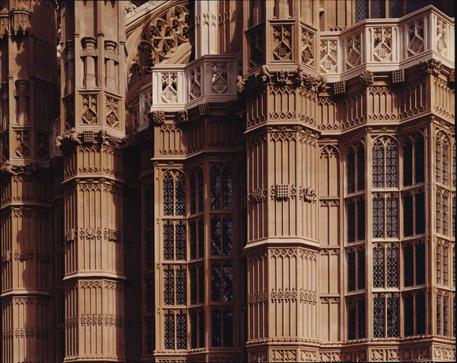
Photograph copyright ©1999 - 2018 Denis Waugh.
External Links
WESTMINSTER ABBEY
Inside Westminster Abbey, memorials of the country's great and good and largely forgotten jostle with each other for space amongst a community of three thousand souls and growing. Even in 1637 there was so little space for Ben Jonson that he had to be buried standing up. And who, one wonders, had to be elbowed aside to make room for the huge floor plaque for Sir Winston Churchill?
Three centuries before Edward the Confessor realized his dream of an abbey here, and five centuries before the present structure was begun by Henry III, the great King Offa of Mercia (757-796) founded a monastery here, on `that terrible place' the Island of Thorney. Legend also attributes a Christian church to a second-century king, Lucius, and another, consecrated by Saint Peter himself, to King Sebert, a seventh-century East Saxon. St Dunstan, Bishop of London in 957, founded a Benedictine monastery here.
Westminster's great abbey is a glorious mix of periods and traditions, of English and French, Gothic and Perpendicular. Edward began in 1040 in the Norman tradition and Henry III, a devotee of Edward, began rebuilding in 1245, surprisingly demolishing much of Edward's work as he went, regardless of the fact that his intention was to build a shrine for the Confessor, canonised in 1161. Much of the work in his time was financed by taxes and appallingly heavy fines on the Jewish community, anti-Semitism having conveniently been rendered practically a Christian duty by the crusades.
Henry III built the beautiful Chapterhouse in 1240-50. It was used for meetings, debates and for early sessions of parliament. But despite the huge amount of money spent on the abbey project, it was left to Henry VII (1485-1509) to build the great nave.
Hard as it is to imagine this famous building without them, it is interesting to try viewing it without the two great western towers, added only in the eighteenth century by Sir Nicholas Hawksmoor.
Edward's vision nearly a thousand years ago was for both a coronation and a final resting place for England's kings, and a few days after the consecration of the chancel in December 1065, it was used for both. His greatest achievement complete, he was laid to rest here on 6 January 1066. On the same day, with what could seem indecent haste, his successor, the charismatic Harold Godwinson, was crowned in order to send a clear message to William (the Bastard) of Normandy that the throne long promised him was no longer available. But just eleven months later there was a second coronation: that of William I, no longer styled Bastard, but rather Conqueror. Since then, with only two exceptions, Edwards V and VIII, every British monarch has been anointed here.
But it has not always been treated with respect. During the Civil War in 1643 soldiers were quartered here. They used Henry VII's altar as a table, destroyed medieval stained glass and paintings, used the altar rails for firewood and smashed the organ. The screen beside the Confessor's tomb shows signs of the damage inflicted.
And even today the fanned vaulting of Henry's soaring nave resounds less to the chant of plainsong and the murmur of prayer than to the clatter and shuffle of millions of tired and often reluctant feet obliterating all trace of those buried under its memorials, the ringing tones of tour guides in multifarious languages giving out their frequently repeated spiels and tired jokes: `Henry the Eighth is not here... King James the First... Not by Henry but another king, it doesn't matter who... If you've ever heard the expression perpendicular... It was the Queen who... Never in the field of human conflict... Shoot the buggers down as they crossed the channel...' Bombers, you may argue, but I know what I heard.
Then something quite extraordinary happens. Over a loudspeaker a gentle voice reminds us that Westminster Abbey is a place of pilgrimage and of prayer and we are invited to join in a minute's meditation. For just a moment, it is almost quiet.
Text copyright ©1999 - 2018 Priscilla Waugh.